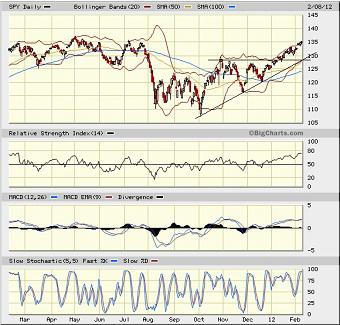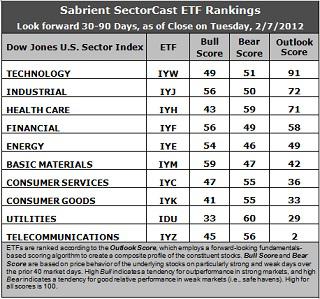 The stock market is behaving extremely well from a technical perspective. And why not? The world seems stable enough to give investors the confidence to maintain a “risk-on” allocation. Sure, there is still plenty to worry about. But more and more, investors are growing bolder. The Dow is at its highest level since 2008 and wants to challenge 13,000. The Nasdaq is at its highest level since 2000.
The stock market is behaving extremely well from a technical perspective. And why not? The world seems stable enough to give investors the confidence to maintain a “risk-on” allocation. Sure, there is still plenty to worry about. But more and more, investors are growing bolder. The Dow is at its highest level since 2008 and wants to challenge 13,000. The Nasdaq is at its highest level since 2000.
All the central banks are joining forces to keep debt-laden countries solvent and prevent Europe (and by extension, the planet) from falling back into recession. And in this election year, the Obama administration is ensuring that all efforts are focused on supporting the economy and creating an environment conducive to job growth. History shows that re-election is nearly impossible otherwise. Although the longer-term impact of all this fiat liquidity flooding the globe is uncertain, for now it is doing its job well.
What else? Well, consumers are spending again, which is fueling expansion in the manufacturing sector. Even GM is back on top as the best-selling automaker. And then there’s the resurgent IPO market, with last week’s Facebook filing getting investors all atwitter (pun intended). In fact, things are going so well that even our less-than-loveable TSA is lightening up a bit and introducing a “Trusted Traveler” program to greatly shorten the screening process for frequent fliers. Yes, life is good…or at least it’s improving.
Among the 10 U.S. sector iShares, Financial (IYF), Energy (IYE) and Technology (IYW) have been leaders lately. And as I’ll discuss shortly, the Sabrient SectorCast ETF rankings continue to display an increasingly bullish bias.
As usual, the main worry has to do with Greece. Last I heard on Wednesday night as I write this is that a deal is almost done. The severity of the reforms and austerity program has been tough for all members of the coalition government to swallow, but they have little bargaining power given Greece’s desperate need for rescue funds and a bond swap. Optimistic bulls seem to be expecting (or hoping for) a deal to happen imminently.
Looking at the SPY chart, the market is still consolidating in place while working off its overbought technicals, but it there is no denying that it is behaving extremely well. Morning weakness is invariably met with buyers during the day, leading to a strong finish. This is bullish behavior. The only fly in the ointment is the persistently low trading volume, which tells me that individual investors are still reluctant to enter the market while institutional investors continue to accumulate shares.

RSI, MACD, and Slow Stochastic are all quite overbought. I expect to see a final push to challenge the highs from last summer, but before a strong breakout occurs, the market really needs to cycle back down to short-term oversold, and perhaps test the uptrend line, which coincides with the first line of support at 128. This would provide much better footing from which to launch an assault on those highs.
The VIX (CBOE Market Volatility Index—a.k.a. “fear gauge”) closed Wednesday at 18.16, which (like the overall market) is about where it has closed the prior two Wednesdays. This is bullish for stocks as it indicates a lack of investor fear. Some observers are calling for a market reversal due to the low VIX, but VIX is not the best market timing indicator. It could stay low for quite a while, although it might spike a bit on any market pullback (such as to work off the overbought technicals).
The TED spread (indicator of credit risk in the general economy, measuring the difference between the 3-month T-bill and 3-month LIBOR interest rates) continues to retreat. It closed Wednesday at 43.70 bps. The trend change from its recent highs near 60 reflects improving investor confidence—although it is still well above the teens we saw early last year.
Short of a major external event that spooks the markets, I fully expect a powerful breakout to occur within the next several weeks. The bulls are quite simply getting their ducks in a row.
Latest rankings: The table ranks each of the ten U.S. industrial sector iShares (ETFs) by Sabrient’s proprietary Outlook Score, which employs a forward-looking, fundamentals-based, quantitative algorithm to create a bottom-up composite profile of the constituent stocks within the ETF. In addition, the table also shows Sabrient’s proprietary Bull Score and Bear Score for each ETF.
High Bull score indicates that stocks within the ETF have tended recently toward relative outperformance during particularly strong market periods, while a high Bear score indicates that stocks within the ETF have tended to hold up relatively well during particularly weak market periods. Bull and Bear are backward-looking indicators of recent sentiment trend.
As a group, these three scores can be quite helpful for positioning a portfolio for a given set of anticipated market conditions.

Observations:
1. Technology (IYW) remains at the top of the Outlook rankings, but it’s even more firmly entrenched as its score has jumped another 10 points to 91. This is quite bullish. Healthcare (IYH) has dropped to third, as a surging Industrial (IYJ) edged up to second place with a score of 72. IYH continues to lose analyst positive sentiment while Industrial (IYJ) continues to strengthen in this important metric. IYW is particularly strong in its return ratios as margins remain high in tech products. It is also strong in analyst positive sentiment.
2. Financial (IYF) continues to show a strong (low) projected P/E, as investors remain uncertain about analysts’ earnings projections. Its Bear score continues to climb, which is a positive sign.
3. Telecom (IYZ) still dwells at the bottom of the rankings with a weak score of 2. IYZ remains saddled with the worst return ratios, lack of analyst support, and one of the highest projected P/Es. It is now joined in the bottom two by Utilities (IDU). IDU has poor long-term growth projections and relatively high projected P/E.
4. Looking at the Bull scores, IYM has been the leader on strong market days, scoring 59, followed by IYF and IYJ at 56. Utilities (IDU) is by far the weakest on strong days, scoring a meager 33.
5. As for the Bear scores, IDU is the investor favorite “safe haven” on weak market days, with a score of 60 (which continues to fall), followed by IYH at 59. IYE displays the lowest Bear score of 46, which means that stocks within this ETF sell off the most on weak market days. IYM is also weak with a score of 47.
6. Overall, IYW shows the best combination of Outlook/Bull/Bear scores. Adding up the three scores gives a total of 191. IYZ is the worst at 103. IYJ and IYM show the best combination of Bull/Bear with a total score of 106, while IDU has the worst combination at 93, as a decidedly bullish market prefers racier alternatives to defensive Utilities and Consumer Goods stocks.
Top ranked stocks in Technology and Industrial include Alliance Data Systems (ADS), SYNNEX Corp (SNX), Cummins Inc (CMI), and TransDigm Group (TDG). These scores represent the view that the Technology and Industrial sectors may be relatively undervalued overall, while Utilities and Telecom sectors may be relatively overvalued based on our 1-3 month forward look. The bottom three (IYZ, IDU, and IYK) are all defensive sectors, which reinforces the overall bullish outlook.
Disclosure: Author has no positions in stocks or ETFs mentioned.About SectorCast: Rankings are based on Sabrient’s SectorCast model, which builds a composite profile of each equity ETF based on bottom-up scoring of the constituent stocks. The Outlook Score employs a fundamentals-based multi-factor approach considering forward valuation, earnings growth prospects, Wall Street analysts’ consensus revisions, accounting practices, and various return ratios. It has tested to be highly predictive for identifying the best (most undervalued) and worst (most overvalued) sectors, with a one-month forward look.
Bull Score and Bear Score are based on the price behavior of the underlying stocks on particularly strong and weak days during the prior 40 market days. They reflect investor sentiment toward the stocks (on a relative basis) as either aggressive plays or safe havens. So, a high Bull score indicates that stocks within the ETF have tended recently toward relative outperformance during particularly strong market periods, while a high Bear score indicates that stocks within the ETF have tended to hold up relatively well during particularly weak market periods.
Thus, ETFs with high Bull scores generally perform better when the market is hot, ETFs with high Bear scores generally perform better when the market is weak, and ETFs with high Outlook scores generally perform well over time in various market conditions.
Of course, each ETF has a unique set of constituent stocks, so the sectors represented will score differently depending upon which set of ETFs is used. For Sector Detector, I use ten iShares ETFs representing the major U.S. business sector.
About Trading Strategies: There are various ways to trade these rankings. First, you might run a sector rotation strategy in which you buy long the top 2-4 ETFs from SectorCast-ETF, rebalancing either on a fixed schedule (e.g., monthly or quarterly) or when the rankings change significantly. Another alternative is to enhance a position in the SPDR Trust exchange-traded fund (SPY) depending upon your market bias. If you are bullish on the broad market, you can go long the SPY and enhance it with additional long positions in the top-ranked sector ETFs. Conversely, if you are bearish and short (or buy puts on) the SPY, you could also consider shorting the two lowest-ranked sector ETFs to enhance your short bias.
However, if you prefer not to bet on market direction, you could try a market-neutral, long/short trade—that is, go long (or buy call options on) the top-ranked ETFs and short (or buy put options on) the lowest-ranked ETFs. And here’s a more aggressive strategy to consider: You might trade some of the highest and lowest ranked stocks from within those top and bottom-ranked ETFs, such as the ones I identify above.

